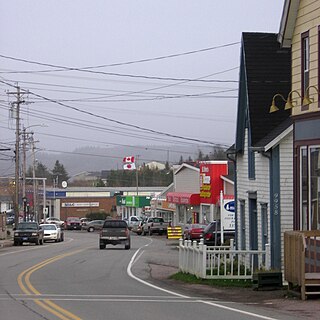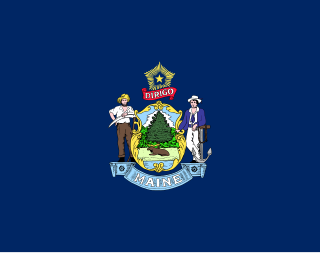Related Research Articles

Port-Royal National Historic Site is a National Historic Site located on the north bank of the Annapolis Basin in the community of Port Royal, Nova Scotia, Canada. The site is the location of the Habitation at Port-Royal.

El Morro National Monument is a U.S. national monument in Cibola County, New Mexico, United States. Located on an ancient east–west trail in the western part of the state, the monument preserves the remains of a large prehistoric pueblo atop a great sandstone promontory with a pool of water at its base, which subsequently became a landmark where over the centuries explorers and travelers have left personal inscriptions that survive today.

St. Peter's is a small incorporated village located on Cape Breton Island in Richmond County, Nova Scotia, Canada.

Ram Island Ledge Light is a lighthouse in Casco Bay, Maine, United States, marking the northern end of the main channel leading the harbor of Portland, Maine.

The Graves Light is a lighthouse located on The Graves, the outermost island of the Boston Harbor Islands National Recreation Area, and 9 miles (14 km) offshore of downtown Boston, Massachusetts, USA.

The following outline is provided as an overview of and topical guide to the U.S. state of Maine:

The Saint George River is a river in Maine with a watershed of 225 square miles (580 km2) in a unique and historic area of mountains, sea coast, lakes, tidal streams and inlets. The origin of the Saint George River is the outflow of Saint George Lake in Liberty. The river follows a winding course 45 miles (72 km) south to Thomaston, where the river flows into the estuary and runs about 12 miles (19 km) southwest to Muscongus Bay, forming the border between Cushing and St. George.

The Garage at 219 Main Street in Farmington, Maine, was once a Free Will Baptist Meetinghouse. Built in 1835, it is one of a relatively small number of 19th-century brick meeting houses, and its history exhibits the creative reuse of structures in rural Maine. It was listed on the National Register of Historic Places in 1973.
Allen Island or Allen's Island is a 450-acre (180 ha) private island which is part of St. George, Knox County, Maine, United States. it is located near the southeastern end of Muscongus Bay, roughly midway between the southernmost parts of the St. George's mainland, and Monhegan Island.

Olson House is a 14-room Colonial farmhouse in Cushing, Maine. The house was made famous by its depiction in Andrew Wyeth's Christina's World. The house and its occupants, Christina and Alvaro Olson, were depicted in numerous paintings and sketches by Wyeth from 1939 to 1968. The house was designated as a National Historic Landmark in June 2011. The Farnsworth Art Museum owns the house; it is open to the public.

The Cuban Friendship Urn, also known as the Cuban–American Friendship Urn or USS Maine Memorial, is a marble statue in Washington, D.C., listed on the National Register of Historic Places. The monument originally stood in Cuba to honor the American deaths aboard the USS Maine preceding the Spanish–American War in 1898.

Battery Steele is a United States military fortification on Peaks Island, Portland, Maine in Casco Bay. Completed in 1942 as part of World War II, it is located on 14 acres (5.7 ha) on the oceanside area of the island, formerly part of the Peaks Island Military Reservation. It is named for Harry L. Steele, who was a Coast Artillery officer during World War I. It was armed with two 16-inch MkIIMI guns and, with a 12-inch gun battery at Fort Levett on Cushing Island, replaced all previous heavy guns in the Harbor Defenses of Portland. It was built to protect Casco Bay, particularly Portland harbor, from Kennebunk to Popham Beach in Phippsburg. According to Kim MacIsaac and historian Joel Eastman in An Island at War, “Battery Steele is not only the largest gun battery built on Peaks Island, but also an example of the largest battery ever built anywhere in the United States.” In 1995, after decades of non-use, the Peaks Island Land Preserve, a community land preservation group, formed to purchase the area and forever preserve it as a public space. On October 20, 2005, the property was listed on the National Register of Historic Places. Other coast defense structures on the island include fire control towers and the counterweight for a disappearing searchlight tower.

The Fifth Maine Regiment Community Center is a historic building at 45 Seashore Avenue on Peaks Island, an island neighborhood of Portland, Maine in Casco Bay. It was built in 1888 by American Civil War veterans "as a memorial to their deceased comrades and as a reunion hall for themselves." It was listed on the National Register of Historic Places in 1978 and designated a Greater Portland Landmark in 1984. Today it is open as a museum.
The Wheeler No. 1 Oil Well was the first well drilled in the Drumright-Cushing Oil Field of northeast Oklahoma, near Drumright. The success of the well, drilled in 1912 by Thomas Baker Slick, Sr., led to the development of the Cushing field and gave impetus to the early development of Oklahoma oilfields. The Drumright-Cushing field would go on to produce 310,000 barrels of oil a day at its peak in May 1917. The well made Slick's name as "King of the Wildcatters".

Thomaston, formerly known as Fort St. Georges, Fort Wharf, and Lincoln, is a town in Knox County, Maine, United States. The population was 2,739 at the 2020 census. Noted for its antique architecture, Thomaston is an old port popular with tourists. The town was named after Major General John Thomas.

The Cushing and Hannah Prince House is a historic house at 189 Greely Road in Yarmouth, Maine. Built in 1785 and substantially remodeled about 1830, it is a fine local example of a rural Federal period farmhouse with Greek Revival features. It was listed on the National Register of Historic Places in 1999.
Fisherman Island, or Fisherman's Island, is a 71-acre (29 ha) island, on the central coast of Maine, United States. Located roughly midway between Damariscove Island and the mainland at Ocean Point, the privately owned island has a history of human activity predating the colonial period, and was settled by English fishermen in the 17th century. The island was listed on the National Register of Historic Places in 2015 for the significance of its prehistoric archaeological sites.

Old Baptist Cemetery is a historic cemetery in Yarmouth, Maine, United States. Dating to the late 17th century, it stands on Hillside Street, adjoining the North Yarmouth and Freeport Baptist Meetinghouse, a National Register of Historic Places property, on its southern side. It is the only burial site in the town attached to an extant church building.

Cushing Prince was a member of the Massachusetts House of Representatives from the District of Maine. His former home, at today's 189 Greely Road in Yarmouth, Maine, is now listed on the National Register of Historic Places. It was built in 1785.
References
- 1 2 "National Register Information System". National Register of Historic Places . National Park Service. July 9, 2010.
- ↑ "Timeline of history". Town of Cushing. Retrieved April 10, 2016.
- ↑ Weidensaul, Scott (2012). The First Frontier: The Forgotten History of Struggle, Savagery, and Endurance in Early America. Boston: Houghton Mifflin Harcourt. p. 16. ISBN 9780151015153.